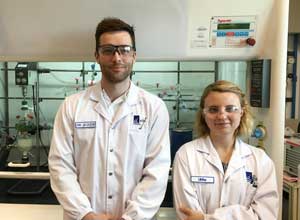Polymer scaffolds build a better pill to swallow

Alexander Jackson and Ulrike Wais. © 2016 A*STAR Institute of Chemical and Engineering Sciences
The huge doses of drugs required to combat cancer could be reduced thanks to the work of Singapore's Agency for Science, Technology and Research (A*STAR) researchers, and the drugs themselves may become more effective. The researchers have developed a polymeric ‘scaffold’ that helps drugs that often have trouble entering the bloodstream, such as anti-cancer agents, form highly stable nanoparticles with improved bioavailability [1].
Many medications that target tumor cells are made from water-repelling hydrocarbon molecules, which require extra processing or high doses rates to enter aqueous biological environments. A safer alternative is to ‘nanosize’ pharmaceuticals into 10 to 1,000 nanometer particles using either mechanical grinding or special crystallization techniques. These extra-small medications easily slip into water and are effective against tumors, but it is hard to prevent them from agglomerating into larger precipitates with less potency.
Ulrike Wais and Alexander Jackson from the A*STAR Institute of Chemical and Engineering Sciences and Haifei Zhang at the University of Liverpool have developed a way to lessen agglomeration problems by using poly(ethylene glycol) and acrylamide (PEG-PNIPAM) — biocompatible polymers that are highly water soluble and can stabilize water-repelling molecules because they have similar surfactant-like hydrocarbon chains.
The team synthesized PEG-PNIPAM into ‘hyperbranched’ spheres that are reinforced with short carbon cross-linking molecules. They then mixed the spheres with test drug compounds such as ibuprofen and blended them together to create an emulsion between the water-repelling and water-attracting components.
The next step required a way to freeze-dry the emulsion so it could be pulverized into nanoparticles, but this involved solving a tricky processing problem. “If phase separation occurs before the sample is completely frozen, drug crystals form that are neither nanosized nor stabilized against agglomeration by the scaffold,” explains Wais.
The researchers prevented phase separation during freeze-drying by ensuring the emulsification was extremely uniform before spraying it as tiny droplets into a pool of liquid nitrogen. Dynamic light scattering and scanning electron microscopy analysis of the solidified emulsion revealed that the drugs and polymer spheres had integrated into a porous, scaffold-like structure.
After mechanically grinding the freeze-dried emulsion into drug nanostructures, the researchers found their open framework made it simple to dissolve them into water. Furthermore, the drugs could be transformed into nanoparticles with yields of 100 per cent using surprisingly low levels of PEG-PNIPAM spheres.
“The polymer structure and level of branching directly affect drug nanoparticle stabilization. This method gives us a way to investigate it systematically,” says Jackson. He notes that this method is synthetically straightforward and could be applied to a wide range of pharmaceuticals.
The A*STAR-affiliated researchers contributing to this research are from the Institute of Chemical and Engineering Sciences. For more information about the team’s research, please visit the Polymer Engineering & Characterisation webpage.
Associated links
Journal information
[1] Wais, U., Jackson, A. W., Zuo, Y., Xiang, Y., He, T. & Zhang, H. Drug nanoparticles by emulsion-freeze-drying via the employment of branched block copolymer nanoparticles. Journal of Controlled Release 222, 141–150 (2016).
Media Contact
More Information:
http://www.researchsea.comAll latest news from the category: Life Sciences and Chemistry
Articles and reports from the Life Sciences and chemistry area deal with applied and basic research into modern biology, chemistry and human medicine.
Valuable information can be found on a range of life sciences fields including bacteriology, biochemistry, bionics, bioinformatics, biophysics, biotechnology, genetics, geobotany, human biology, marine biology, microbiology, molecular biology, cellular biology, zoology, bioinorganic chemistry, microchemistry and environmental chemistry.
Newest articles

First-of-its-kind study uses remote sensing to monitor plastic debris in rivers and lakes
Remote sensing creates a cost-effective solution to monitoring plastic pollution. A first-of-its-kind study from researchers at the University of Minnesota Twin Cities shows how remote sensing can help monitor and…

Laser-based artificial neuron mimics nerve cell functions at lightning speed
With a processing speed a billion times faster than nature, chip-based laser neuron could help advance AI tasks such as pattern recognition and sequence prediction. Researchers have developed a laser-based…

Optimising the processing of plastic waste
Just one look in the yellow bin reveals a colourful jumble of different types of plastic. However, the purer and more uniform plastic waste is, the easier it is to…



